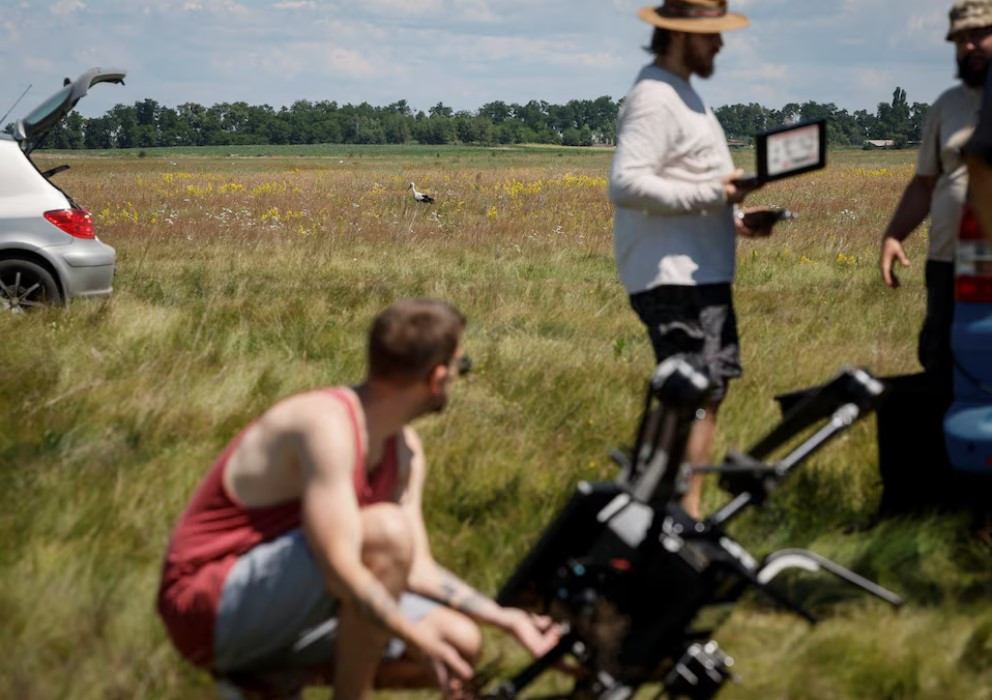
In Ukraine, a handful of startups are developing Artificial Intelligence (AI) systems to help fly a vast fleet of drones, taking warfare into uncharted territory as combatants race to gain a technological edge in battle.
Ukraine hopes a rollout of AI-enabled drones across the front line will help it overcome increasing signal jamming by the Russians as well as enable unmanned aerial vehicles (UAVs) to work in larger groups.
AI drone development in Ukraine is broadly split between visual systems helping identify targets and fly drones into them, terrain mapping for navigation, and more complex programmes enabling UAVs to operate in interconnected "swarms".
One company working on this is Swarmer, which is developing software that links drones in a network. Decisions can be implemented instantly across the group, with a human only stepping in to green-light automated strikes.
"When you try to scale up (with human pilots), it just doesn't work," Swarmer CEO Serhiy Kupriienko told Reuters in the company's Kyiv offices. "For a swarm of 10 or 20 drones or robots, it's virtually impossible for humans to manage them."
Swarmer is one of more than 200 tech firms that have sprung up since Russia launched its full-scale invasion in 2022, with civilians from IT backgrounds developing drones and other devices to help Ukraine counter a much larger enemy.
Kupriienko said that while human pilots struggled to run operations involving more than five drones, AI would be able to process hundreds.
The system, called Styx, directs a web of reconnaissance and strike drones, both large and small, in the air and on the ground. Every drone would be able to plan its own moves and predict the behaviour of the others in the swarm, he said.
As well as scaling up operations, Kupriienko said automation would help protect drone pilots who operate close to the front lines and are a priority target for enemy fire.
Swarmer's technology is still under development and has only been trialled on the battlefield experimentally, he added.
Samuel Bendett, Adjunct Senior Fellow at the Center for a New American Security, said AI drone control systems would likely need a human in the loop to prevent the system making errors in target selection.
There are broad concerns about the ethics of weapons that exclude human judgment. A 2020 European Parliament research paper warned that such systems could commit violations of international humanitarian law and lower the threshold of going to war.
AI is already being used in some of Ukraine's long-range drone strikes which target military facilities and oil refineries hundreds of kilometres inside Russia.
One Ukrainian official, speaking anonymously, told Reuters that the attacks sometimes involve a swarm of about 20 drones.
The core drones fly to the target, but it is the job of others to take out or distract air defences along the way. To do this, they use a form of AI with human oversight to help spot targets or threats and plan possible routes, the source added.
Signal Jamming
The need for AI-enabled drones is becoming more pressing as both sides roll out Electronic Warfare (EW) systems that disrupt signals between pilots and drones.
Small, cheap, FPV (first person view) drones in particular, which became the main way for both sides to hit enemy vehicles in 2023, are seeing their hit rates fall as jamming increases.
"We are already working with the concept that in the near future, there will be no connection on the front line" between pilot and UAV, said Max Makarchuk, the AI lead for Brave1, a defence tech accelerator set up by the Ukrainian government.
According to Makarchuk, the percentage of FPVs that hit their target is constantly falling. Most FPV units now see a strike rate of 30-50%, while for new pilots that can be as low as 10%.
He predicted that AI-operated FPV drones could post hit rates of around 80%.
To counter the EW threat, makers including Swarmer have started developing functions which allow a drone to lock onto a target through its camera.
EW systems form an invisible signal-jamming dome over the equipment and soldiers which they protect.
If a pilot's contact with the drone is cut, they can no longer control it and the craft either plummets to the ground or continues flying straight on.
Automating the final part of a drone's flight to its target means that it no longer needs the pilot – thus nullifying the effect of the EW's jamming.
AI-enabled drones have been in development for years, but had hitherto been seen as expensive and experimental.
Bendett said Russia had been developing AI-enabled aerial and ground drones before the 2022 invasion, and had claimed some successes.
In Ukraine, the key task for manufacturers is to produce an AI targeting system for drones which is cheap. That would allow it to be deployed en masse along the entire 1,000 km (621 mile) front line, where thousands of FPV drones are used up each week.
Costs can be brought down by running AI programmes on a Raspberry Pi, a small, cheap computer which has found global popularity outside the educational purposes it was designed for.
Makarchuk said he estimated the cost of putting in a simple targeting system, which would lock onto a shape visible to the drone's camera, at only about $150 per drone.



1731325890-0/trump-(24)1731325890-0-165x106.webp)


1731836498-0/Untitled-design-(20)1731836498-0-270x192.webp)
1730959638-0/trump-(19)1730959638-0-270x192.webp)
1731836051-0/BeFunk_§_]__-(3)1731836051-0.jpg)
1731830002-0/BeFunk_§_]__-(1)1731830002-0.jpg)
1731829827-0/Untitled-design-(15)1731829827-0-270x192.webp)

1719742957-0/BeFunky-collage-(100)1719742957-0-270x192.webp)







COMMENTS
Comments are moderated and generally will be posted if they are on-topic and not abusive.
For more information, please see our Comments FAQ